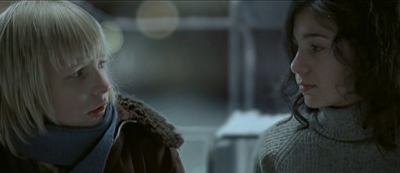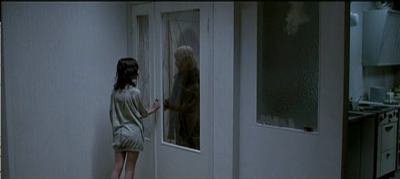Let the Right One In

Or, in the original Swedish, Låt den rätte komma in is the sweet and troubling coming-of-age story of Oskar, a young boy who finds the confidence to fight bullies and assert his place in the world when he falls in love with the girl next door. However, as he gets closer to Eli he realises there might be something sinister about her. Of course there is: she’s a vampire.
Last month I caught up with Twilight, the yardstick by which teenage vampire movies are currently measured. The American vampire movie had plenty of thrills and spills, but it rarely strayed from the established good-girl-meets-dangerous-guy formula – a bit like Dirty Dancing with lots of white goth makeup and little emotional honesty. Let the Right One In is quite different. The tone is measured and, while it’s not as intentionally halting or sparse as Roy Andersson’s Songs from the Second Floor or Aki Kaurismäki’s The Man Without a Past, there’s a similar buttoned-down nihilism underpinning proceedings.
The film does an excellent job of showing the action and allowing the viewer to connect the dots. As a friend of mine says, it allows the characters space to breathe. It also gives the audience a chance to be involved in creating the story in their heads. Much goes unspoken: we are never told exactly what is the nature of the relationship between Eli and the much older man she lives with, we are never told what the consequences of Oskar’s relationship with Eli will be, but we are given sufficient evidence to work it out for ourselves.

Notable visual and audio touches include the shots that mirror Oskar and Eli throughout the film and the way they echo one another in their early dialogue. We know they’re destined to be together well before they do. There’s a great sound editing choice when Oskar is smacked on the face with a riding crop and the ringing in his ears is audible on the soundtrack. Most impressive is the presentation of Eli. Her need for blood is presented as being similar to a drug addiction. When hungry, she is pale, sunken eyed and lank haired, and only looks healthy for a short period after feeding. And yet, throughout the movie it is totally clear how she bewitches Oskar. Most masterful is the suggestion that Oskar, even though he’s a regular human boy, is potentially just as sinister as Eli.
Of course, the title refers to the custom that vampires can only enter a house if they’ve been invited (and there’s a very nice take on the consequences of disobeying this rule) but it equally refers to the need to let the right person into your heart. At its core Let the Right One In is a dark film, in which love is a tender and not-so-tender trap. I doubt the scheduled Hollywood remake will share the same philosophy.
